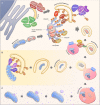MitophAging: Mitophagy in Aging and Disease
- PMID: 32373609
- PMCID: PMC7179682
- DOI: 10.3389/fcell.2020.00239
MitophAging: Mitophagy in Aging and Disease
Abstract
Maintaining mitochondrial health is emerging as a keystone in aging and associated diseases. The selective degradation of mitochondria by mitophagy is of particular importance in keeping a pristine mitochondrial pool. Indeed, inherited monogenic diseases with defects in mitophagy display complex multisystem pathologies but particularly progressive neurodegeneration. Fortunately, therapies are being developed that target mitophagy allowing new hope for treatments for previously incurable diseases. Herein, we describe mitophagy and associated diseases, coin the term mitophaging and describe new small molecule interventions that target different steps in the mitophagic pathway. Consequently, several age-associated diseases may be treated by targeting mitophagy.
Keywords: aging; autophagy; interventions; mitophaging; mitophagy; monogenic disorders.
Copyright © 2020 Bakula and Scheibye-Knudsen.
Figures



References
Publication types
LinkOut - more resources
Full Text Sources

